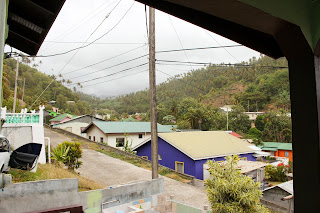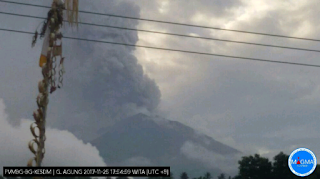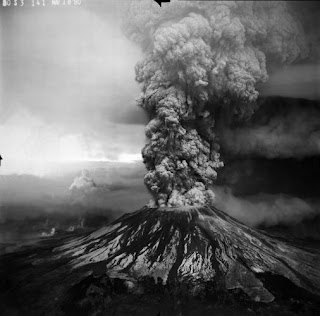Interpreting historic eruptions with old dusty hidden treasures: Introduction to historical and social volcanology
Guest Blogger Jazmin Scarlett
Follow her on Twitter: @scarlett_jazminJazmin shares more of her adventures on her own blog: Phdvolcanology.wordpress.com
My name is Jazmin Scarlett, I am a PhD student in volcanology and I am not trained in geology, geophysics or geochemistry.
I am trained in understanding hazardous processes and how humans interact with them. I am, therefore, a weird mix of physical and social scientist. I understand the processes behind volcanic activity, but I mainly understand the many characteristics of volcanic hazardous phenomena. I understand how they impact on the natural and built environment and in turn, I understand how humans respond, mitigate and prepare against them. However, the interactions between hazard and person is more often than not more complicated than just hazard + human = impact.
As well as understanding the volcano and its hazards, what is around the volcano is just as important. Infrastructure, settlements, topography, climate and so on. Humans are far more complex, so responses, mitigation and preparedness goes beyond what is visible (e.g. running away, building a wall, evacuation drills), it involves understanding what makes us tick when it comes to confronting hazards and risk. This has led me to learning about theories and concepts with sociology, psychology and anthropology.
The village of Byera, located in the high risk volcanic hazard zone.
My approach to ‘social’ volcanology has been a mixture of volcanology, socio-psychology and disaster management. This all started with my masters dissertation into volcanic risk perceptions on the island of St Vincent in the East Caribbean. In order for people to do questionnaires and a semi-structured interview, I first had to learn about the volcano in question, La Soufrière and, its volcanic hazardous phenomena. After that, I had to understand the society, its common problems and other hazardous events (hurricanes, agricultural pests, crime and so on), culture and the country’s take on disaster management and relation to its volcano. After that, it was the matter of being a non-biased and open researcher to get the most representative results as possible.
A street leading to the village of Bellevue in the medium risk volcanic hazard zone.
I learnt so much from the project: about myself, about the island my family is from, about the volcano and importantly, about social volcanology. The sub-discipline itself is quite young, so at the time I felt I got an equal amount of questions and answers! I learnt that the ‘social’ aspect of volcanology involves the need for the researcher to really strip back and understand the society and its connection to its volcano(es) and to be patient with participants. I spoke only to the lay-public, so despite keeping everything as jargon free as possible, there were still things I had to take the time to explain. I was going into the project using human geography techniques…but came out learning about socio-psychology and a bit of anthropology!
The beginning of the Windward volcano trail.
I took all the questions and answers from that project into my current PhD which is still looking at St Vincent. The initial innocent question was: “how did people respond in the past?” and it has now got me using historical geography understanding. My current project is investigating three historical eruptions of La Soufrière impacts on the society, alongside how the society developed with the volcano. This has involved all aspects of social volcanology (perceptions, development, awareness and so on) within the historical context. I have to understand factors such as the economy, colonial relations with the British Empire, the societal hierarchy, the slave plantation system, emancipation and the significance of gaining independence. It is split up into three parts: reconstruction of the eruptions using archive sources (across six different archives in three different countries), impacts on the agriculture sector (sugar, cotton, arrowroot, banana and others) as well as certain parameters of the society (responses, recovery, disaster relief, resilience) that may have influenced the ‘co-volcanic society’ today. ‘Co-volcanic society’ is a new term being created between myself and my supervisors about the reciprocal relationships between volcano and society.

A pile of archive documents related to the 1902 eruption of La Soufrière. These documents belong to The National Document and Archive Service of St Vincent and the Grenadines.
A Barbadian newspaper article with a strong religious reaction to ash fall from the 1902 eruption. Barbados always experiences ashfall from St Vincent due to the dominant Easterly winds.
Part of my historical hazard mapping experience. These are datapoints with descriptive observations of pyroclastic density currents for the 1812 eruption, often referred to as “lava” during this time. They are mapped onto a 1796 map.
On the main Leeward road in the southeast of St Vincent.
School children learning about volcanoes during volcano awareness week 2016 on St Vincent.
Governmental correspondence for Barbados during 1902. Book is within The National Archives in London, UK.
One of my interviewees in the town of Chateaubelair. He shared his experiences of the last eruption in 1979. He moved his family to a safer location south of the island then returned to volunteer helping sick people evacuate.
Being a historical and social volcanologist requires me understanding the volcano and the exposed population within the historical context. It is a unique approach to volcanology and one I am proud to follow. There are many ways to understanding volcanoes, mine is just one of them.
Photograph taken by volcanologist Dr Tempest Anderson at the Orange Hill Estate house after a pyroclastic density current on the 7th May 1902. Photographs held at the Yorkshire Museum, UK.
Diary entries from American barrister Hugh Keane, who observed the 1812 eruption. Diary held at the Virginia Historical Society, Richmond, VA















